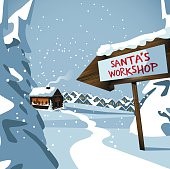North Pole Medical Mystery SOLVED!
Posted on by
Crisis averted. Barring severe weather issues or a catastrophe, it looks like children around the world will receive their presents now that the elves are healthy and back at work. (Read the case details here). After Santa requested a NIOSH Health Hazard Evaluation, NIOSH researchers were mysteriously transported to the North Pole to try to figure out what was causing elves in the toy shop to suffer from congestion, cough, shortness of breath, sore throats, burning eyes, and fatigue.
NIOSH researchers interviewed the elves concerning their health and work environment. Researchers also conducted air sampling. NIOSH investigators evaluated the toy shop ventilation system and the dust collector using a smoke machine. The local exhaust ventilation (LEV) system in the toy shop was also evaluated.
The culprit was a clogged ventilation system. The mice who were moved from the toy shop attic built a new nest in the exhaust ducting. This prevented the dust generated by the toy makers’ hand routers, hand disc sanders, band sanders, and mitre saws, from clearing out of the toy shop. The high exposures to wood dust particles in the air were causing the elves’ symptoms.
 Fortunately, this was caught early. Workers exposed to wood dusts have experienced a variety of adverse health effects such as eye and skin irritation, allergy, reduced lung function, asthma, and nasal cancer. Airborne wood dust exposures have been associated with mucosal irritation, bronchitis, hypersensitivity pneumonitis, impairment of respiratory function, and asthma.1 An association between exposures to airborne wood dust and an increased risk of nasal tumors (primarily adenocarcinomas, a type of cancer that forms in the glands) has also been reported.2
Fortunately, this was caught early. Workers exposed to wood dusts have experienced a variety of adverse health effects such as eye and skin irritation, allergy, reduced lung function, asthma, and nasal cancer. Airborne wood dust exposures have been associated with mucosal irritation, bronchitis, hypersensitivity pneumonitis, impairment of respiratory function, and asthma.1 An association between exposures to airborne wood dust and an increased risk of nasal tumors (primarily adenocarcinomas, a type of cancer that forms in the glands) has also been reported.2
In most cases, the component in wood dust that brings about these conditions is not fully understood. Some of the conditions have been related to chemical compounds contained within the wood dust, mechanical irritation due to the dust, and mold or mold metabolic products in the wood. Although exposure to several different types of hardwood dust has been shown to cause work-related asthma in exposed individuals, the prevalence of work-related asthma due to wood dust is not known.3 Hypersensitivity pneumonitis and cryptogenic fibrosing alveolitis, lung diseases related to wood dust exposure, can result in pulmonary fibrosis and restrictive lung changes.4 Most cases of hypersensitivity pneumonitis related to wood dust have been noted in sawmill and paper mill workers.3,4 The International Agency for Research on Cancer has classified hardwood dust as cancer-causing to humans.5
OSHA regulates wood dust exposure under the requirements for Particulates Not Otherwise Regulated (PNOR). This standard sets the PEL for an 8-hour TWA exposure to total airborne wood dust at 15 mg/m3.4. However, NIOSH recommends a more protective exposure limit of 1 mg/m3 as a TWA for up to a 10-hour workday and 40-hour workweek based on the risk of pulmonary dysfunction, respiratory effects, and its potential as an occupational carcinogen.6
NIOSH recommends engineering controls on wood working stations to reduce exposure to wood dust. A series of NIOSH publications describe control systems that successfully reduce dust emissions on routers and hand sanders:
- HC4 Control of Wood Dust from Horizontal Belt Sanders
- HC5 Control of Wood Dust from Shapers
- HC6 Control of Wood Dust from Automated Routers
- HC7 Control of Wood Dust from Large Diameter Disc Sanders
- HC8 Control of Wood Dust from Random Orbital Hand Sanders
- HC9 Control of Wood Dust from Orbital Hand Sanders
- HC10 Control of Wood Dust from Table Saws
While this was a fictitious medical mystery, the health effects from wood dust are real. We hope this holiday blog will help draw attention to the hazards of wood dust exposure and how to prevent them. Check out our other workplace medical mysteries.
Have a happy and safe holiday season!
Julie Tisdale-Pardi, MA, is the NIOSH Science Blog Coordinator.
For more information see:
Health Effects of Exposure to Wood Dust and Wood Dust References
References
- Hathaway GJ, Proctor NH, and Hughes JP [1996]. Proctor and Hughes’ Chemical Hazards of the Workplace. 4th ed. New York, NY: Van Nostrand Reinhold.
- IARC [1987]. IARC Monographs on the Evaluation of Carcinogenic Risk of Chemicals to Humans, Overall Evaluations of Carcinogenicity: An Updating of IARC Monographs Vols 1 to 42, Suppl 7, pp 378-380. Lyon, France, International Agency for Research on Cancer.
- Bernstein IL, Chan-Yeung M, Malo JL, et. al., eds. [1993] Asthma in the Workplace. New York: Marcel Dekker, 503-31.
- Hubbard R, Lewis S, Richards K, et. al. [1996] Occupational exposure to metal or wood dust and aetiology fo cryptogenic fibrosing alveolitis. Lancet. 347:284-89.
- CFR [1997]. 29 CFR 1910.1000. Code of Federal regulations. Washington, DC: U.S. Government Printing Office, Office of the Federal Register.
Posted on by

